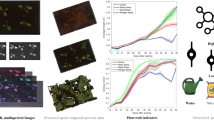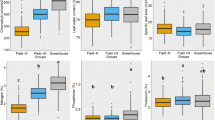Abstract
While both water and nitrogen (N) are necessary for crop output and quality, excessive N application increases production costs and environmental degradation. Recent years have seen the development of NUE and WUE assessment tools, which have shown value. This chapter discusses the properties of next-generation phenomics that are critical for recognising rice genotypes during periods of water scarcity. In addition to the newly proposed one, the experiment featured non-imaging hyperspectral remote sensing, thermal imaging, and colour and multispectral imaging sensors from the ground and aerial platforms. Numerous multivariate models for the non-invasive evaluation of rice plants’ relative water content (RWC) and sugar content were examined using spectral reflectance data gathered in the 350–2500 nm spectral region. Differentiating rice genotypes was accomplished using spectral data. A crop water stress score developed from thermal imaging of selected rice genotypes may be used to identify rice with high drought resistance and low drought sensitivity. The researchers used multispectral and RGB sensors mounted on a drone for field remote sensing and heat map map** to record the distinct responses of various genotypes and characteristics. The procedures established are rapid, low-cost, and non-invasive, providing a viable alternative to traditional approaches. These techniques are now being used to do high-throughput plant phenoty** in water scarcity and nutrient deficiency conditions.
Access this chapter
Tax calculation will be finalised at checkout
Purchases are for personal use only
Similar content being viewed by others
References
Arya S, Sandhu KS, Singh J, Kumar S (2022) Deep learning: as the new frontier in high-throughput plant phenoty**. Euphytica 218(4):1–22
Awika JM (2011) Major cereal grains production and use around the world. In: Advances in cereal science: implications to food processing and health promotion. American Chemical Society, Washington, DC, pp 1–13
Fiorani F, Schurr U (2013) Future scenarios for plant phenoty**. Annu Rev Plant Biol 64:267–291. https://doi.org/10.1146/annurev-arplant-050312-120137
Furbank RT (2009) Plant phenomics: from gene to form and function. Funct Plant Biol 36:10–11
Furbank RT, Tester M (2011) Phenomics--technologies to relieve the phenoty** bottleneck. Trends Plant Sci 16:635–644
James RA, Sirault XRR (2012) Infrared thermography in plant phenoty** for salinity tolerance. In: Shabala S, Cuin TA (eds) Plant salt tolerance: methods and protocols. Humana Press, Totowa, NJ, pp 173–189
Jones HG, Serraj R, Loveys BR, **ong L, Wheaton A, Price AH (2009) Thermal infrared imaging of crop canopies for the remote diagnosis and quantification of plant responses to water stress in the field. Funct Plant Biol 36:978–989
Kastberger G, Stachl R (2003) Infrared imaging technology and biological applications. Behav Res Methods Instrum Comput 35:429–439
Kirkpatrick M, Heckman N (1989) A quantitative genetic model for growth, shape, reaction norms, and other infinite-dimensional characters. J Math Biol 27:429–450
Kumar S, Raju D, Sahoo RN, Viswanathan C (2016) Phenomics: unlocking the hidden genetic variation for breaking the barriers in yield and stress tolerance. Indian J Plant Physiol 21:409–419
Lobet G, Pages L, Draye X (2011) A novel image-analysis toolbox enabling quantitative analysis of root system architecture. Plant Physiol 157:29–39
Mishra AK, Singh VP (2010) A review of drought concepts. J Hydrol 391:202–216
Momen M, Campbell MT, Walia H, Morota G (2019) Predicting longitudinal traits derived from high-throughput phenomics in contrasting environments using genomic Legendre polynomials and B-splines. G3 (Bethesda) 9(10):3369–3380
Moreira FF, Oliveira HR, Volenec JJ, Rainey KM, Fiorani F, Schurr U (2013) Future scenarios for plant phenoty**. Annu Rev Plant Biol 64:267–291
Paproki A, Sirault X, Berry S, Furbank R, Fripp J (2012) A novel mesh processing-based technique for 3D plant analysis. BMC Plant Biol 12(1):1–13
Passioura J (2006) Increasing crop productivity when water is scarce—from breeding to field management. Agric Water Manag 80(1–3):176–196
Ray DK, Mueller ND, West PC, Foley JA (2013) Yield trends are insufficient to double global crop production by 2050. PLoS One 8:e66428
Revollon P, Chasseriaux G, Riviere LM, Gardet R (1998) The use of image processing for tracking the morphological modification of forsythia following an interruption of watering. In: Proceedings of the international conference on agricultural engineering. AgEng, Oslo
Seelig HD, Hoehn A, Stodieck LS (2008) The assessment of leaf water content using leaf refectance ratios in the visible, near-, and short-wave-infrared. Int J Remote Sens 29:3701–3713
Topp CN, Anjali SI, Anderson JT (2013) 3D phenoty** and quantitative trait locus map** identify core regions of the rice genome controlling root architecture. Proc Natl Acad Sci U S A 110:1695–1704
Varshney RK, Terauchi R, McCouch SR (2014) Harvesting the promising fruits of genomics: applying genome sequencing technologies to crop breeding. PLoS Biol 13:528–530
Weirman A (2010) Plant phenomics teacher resource. http://www.plantphenomics.org.au/files/teacher/Final_Phenomics_for_word_with_images.doc. Accessed 9 Nov 2021
Yang W, Duan L, Chen G, **: accelerating rice functional genomics using multidisciplinary technologies. Curr Opin Plant Biol 16:180–187. https://doi.org/10.1016/j.pbi.2013.03.005
Zhao Y, Zheng B, Chapman SC, Laws K, George-Jaeggli B, Hammer GL, Jordan DR, Potgieter AB (2021) Detecting sorghum plant and head features from multispectral UAV imagery. Plant Phenomics 2021:9874650. https://doi.org/10.34133/2021/9874650
Author information
Authors and Affiliations
Editor information
Editors and Affiliations
Rights and permissions
Copyright information
© 2023 The Author(s), under exclusive license to Springer Nature Singapore Pte Ltd.
About this chapter
Cite this chapter
Sahoo, R.N. et al. (2023). High-Throughput Phenomics of Crops for Water and Nitrogen Stress. In: Harohalli Masthigowda, M., Gopalareddy, K., Khobra, R., Singh, G., Pratap Singh, G. (eds) Translating Physiological Tools to Augment Crop Breeding. Springer, Singapore. https://doi.org/10.1007/978-981-19-7498-4_13
Download citation
DOI: https://doi.org/10.1007/978-981-19-7498-4_13
Published:
Publisher Name: Springer, Singapore
Print ISBN: 978-981-19-7497-7
Online ISBN: 978-981-19-7498-4
eBook Packages: Biomedical and Life SciencesBiomedical and Life Sciences (R0)




